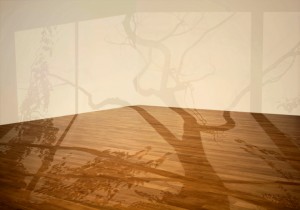
Mary Temple, an artist formerly featured at Baylor’s Martin Museum, opens an installation at Rice University Art Gallery with the help of Hana Shoup, a 2007 Baylor grad.
By Liz Hitchcock
Reporter
Artist Mary Temple, who was formerly featured at Baylor, along with her assistants, one of whom graduated from Baylor, set up an installation at Rice University’s art gallery this past week. The installation is titled Northwest Corner, Southeast Light, and covers three walls and a large space on the hardwood floor of the gallery.
Using latex paint and wood stain, Temple creates images of light pouring through a window and reflecting on the surfaces in the room.
Detailed depictions of shadows cast by branches, leaves and windowsills, create an image that tricks the viewer into believing there is a window nearby.
This specific piece is part of Temple’s series of light installations that she began in 2002, according to the Rice Gallery’s website, and is an ongoing progression of installations.
“There is a pool of light that you are able to walk into and onto the hardwood surface, but when you do, you realize that you cannot cast a shadow on this shard of light… and on closer inspection, you realize that everything that looks like light interior is either a stain on the hardwood floors or paint,” Temple said about her most recent installation.
One of Temples’ assistants is a Baylor alumna, Hana Shoup. Shoup graduated in 2007 with a Bachelor of Fine Arts and was chosen because of her painting skills.
Although it may seem like Temple’s paintings are one color of paint contained in a simple outline, there is a fastidious method to obtaining the exact consistency of paint needed to fool the eye.
“It’s very precise work. We had to make sure that our brush strokes were even and matched every one else’s in order to create this optical illusion,” Shoup said.
Julia Hitchcock, associate professor of art at Baylor, attended graduate school at Arizona State University with Temple, and she invited her to speak at Baylor.
“Mary Temple and I went to ASU and were both graduate students, studying figurative painting, and we were both oil painters,” Hitchcock said. “She changed from figurative painting to abstraction before she graduated.”
In 2004 Temple was invited to Baylor’s art department as a visiting artist and gave a lecture. In 2006 her work was shown at the Martin Museum.
“I had met Mary Temple previously at Baylor in Spring 2004 when she visited Julia’s Drawing II class, and I was in that class,” Shoup said. “So, it was really neat to be able to meet her again and work with her.”
Hitchcock recalled Temple’s work from their time at ASU, remembering that she used line and colors to indicate spatial separation and platforms, but now Temple creates these illusions using light and illumination.
“Her abstractions were extremely large paintings, so it seems normal for her to be doing what she is now,” Hitchcock said.
Hitchcock said Temple creates intricate models of the spaces she shows in, making her installations extremely site specific.
“All the colors she uses are meticulously chosen to work with the space,” Hitchcock said. “She creates these small models of the spaces she will be working in and plans exactly how the light will be cast inside of them.”
Joshua Fischer, the assistant curator for the Rice Gallery, said the reason they chose Temple is because of her ability to work within a space and create installations specifically for the gallery space.
“The director of the gallery saw her work at a couple different museums. The artists that are shown here are always chosen by the way they can work in the entire gallery space. We do large-scale installations,” Fischer said. “Her work fit that kind of mission. She works with the entire gallery space. … It causes the illusion that light is completely flooding the gallery space.”
Temple is currently showing at a couple other very prestigious institutions, including the San Francisco Museum of Modern Art and even a permanent installation in the Q line subway in New York City.
She encourages aspiring artists to continue to do work that they love.
“Find a place where you can work, and do the best work that you can. … Find a community where you can show this work. As artists we are creating work to communicate with someone; at least for me, I want some one to be able to respond to that work.”
Temple’s installation will be featured February 3 through May 25 at Rice University Art Gallery at 6100 Main Street, Houston, Texas 77005. Admission is free and open to the public.





